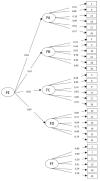Validation of the Bar-On EQ-i: YV (S) Inventory in Its Spanish Version: Gender-Based Invariance Analysis
- PMID: 33572163
- PMCID: PMC7915157
- DOI: 10.3390/ijerph18041643
Validation of the Bar-On EQ-i: YV (S) Inventory in Its Spanish Version: Gender-Based Invariance Analysis
Abstract
The purpose of this work is to verify the factorial structure and analyze the reliability of the Emotional Quotient Inventory (EQ-i): Youth Version (YV) (S) by evaluating emotional intelligence in a more extensive sample of Spanish adolescents than has been used to date, since this inventory has been employed in various studies but with a very limited number of participants. For this study, 5292 adolescents from all over Spain participated-male (51.2%) and female (48.8%) secondary education students between 11 and 19 years old, with an average age of 14.33. Data analysis included a Confirmatory Factor Analysis (CFA), reliability analysis, and model invariance as a function of gender. The CFA confirms that the data empirically support the theoretical model and that the goodness-of-fit indexes are adequate. The reliability analysis of the inventory presents a Cronbach's alpha coefficient for the total scale of 0.76, and reliability indexes for each of the factors range between 0.63 and 0.80. The findings show that the model indicates invariance related to gender.
Keywords: Bar-On EQ-i: YV (S); emotional intelligence; factorial structure; model invariance; psychometric properties.
Conflict of interest statement
The authors declare no conflict of interest.
Figures

References
-
- Molero C., Saiz E., Esteban C. Revisión histórica del concepto de inteligencia: Una aproximación a la inteligencia emocional (Historical review of the concept of intelligence: An approach to emotional intelligence) Rev. Latinoam. Psicol. 1998;30:11–30.
-
- Thorndike E.L. Intelligence and its uses. Harpers Mag. 1920;140:227–235.
-
- Bisquerra R. Psicopedagogía de las Emociones (Psychopedagogy of Emotions) Síntesis; Madrid, Spain: 2009.
-
- Gardner H. Frames of Mind: The Theory of Multiple Intelligences. Basic Books; New York, NY, USA: 1983.
-
- Gardner H. Intelligence Reframed. Basic Books; New York, NY, USA: 1999.
Publication types
MeSH terms
LinkOut - more resources
Full Text Sources
Other Literature Sources

